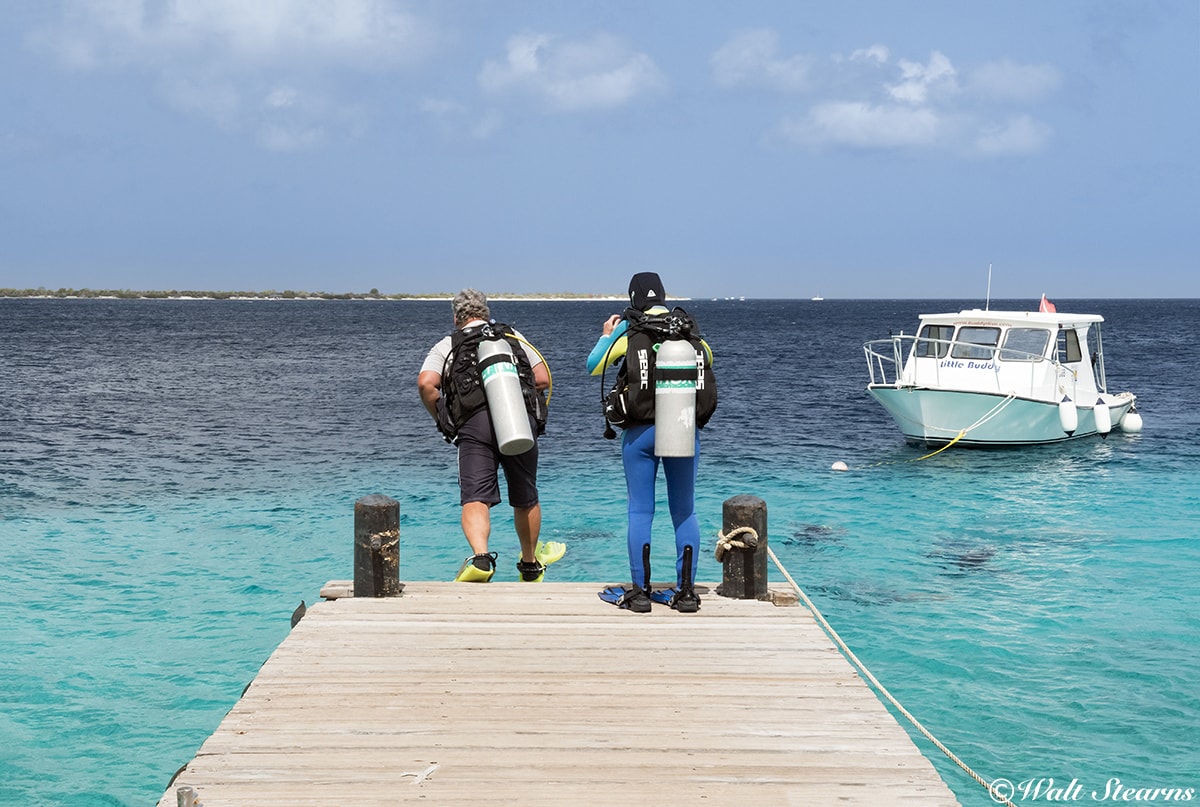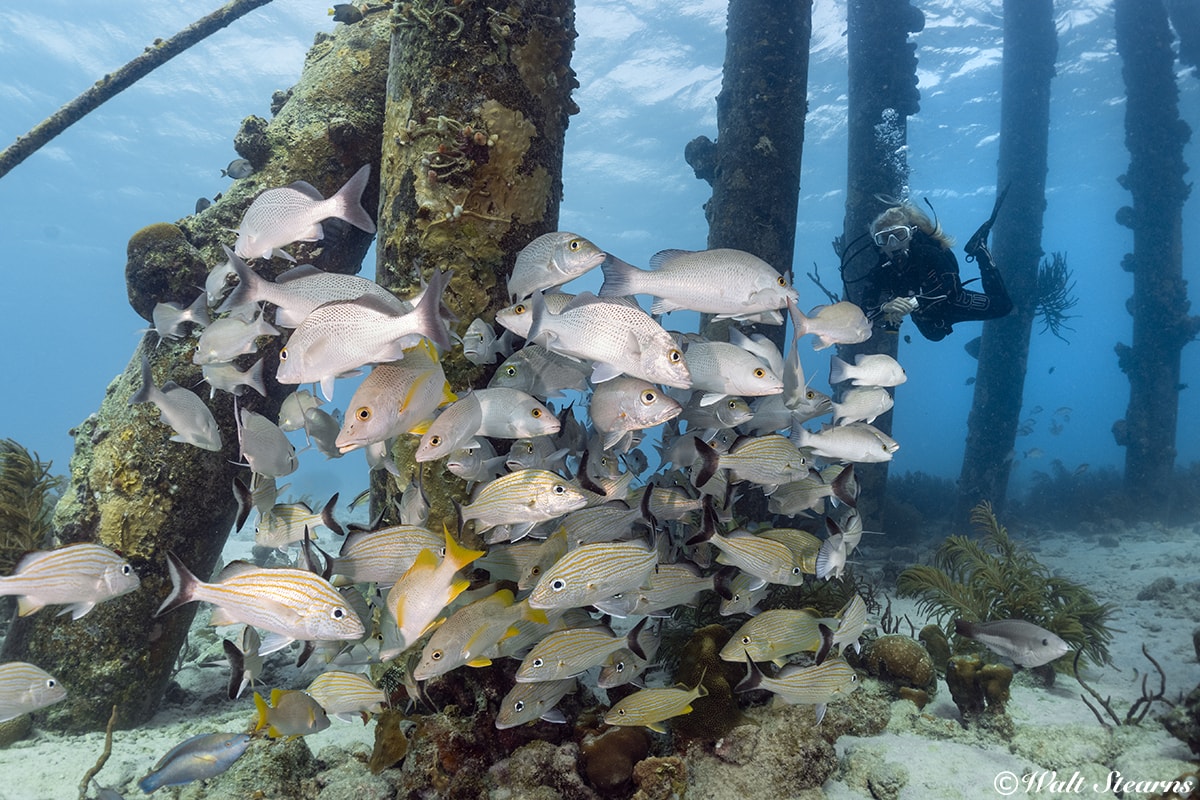
Learn how to make shore diving in Bonaire easy
There's a good reason why Bonaire is known as the Shore Diving Capital of the Caribbean. More than 50 named sites are scattered along the island's shoreline, giving divers convenient 24/7 access to reefs that lie just a few fin kicks away. Bonaire veterans have honed their shore diving skills to a fine art, but even first-timers soon get the hang of land-based diving and become enthusiastic converts to the easy freedom this type of diving allows. Here are some simple tips that can help make shore diving safe, easy and enjoyable.

1. Get The Truck
All shore diving sites in Bonaire can be reached by road, and the vehicle of choice for most shore diving veterans is a compact four-door pickup. These utilitarian vehicles can hold two buddy pairs and once parked, tailgates become gearing up stations. Many of the dive packages offered by Caradonna include a pickup rental.

2. Boot Up
Water entries on Bonaire shores can vary from sandy beaches to rocky slopes. Open heel fins are the best call. To ensure comfort and sure footing when traversing gravel or rocks, pair them with sturdy-soled dive boots. As you enter the water, the simplest plan may seem like holding both fins by the straps, using one hand. This works, but if you are in a tricky situation that could require the use of both hands, you might also try looping a wrist through the fins straps to keep the palm of the hand free.

3. Lighten Up
Even when the walk to the water is short and easy, there's no need to burden yourself with extra weight. Begin by using only as much weight as you actually need. A good time to figure that out is during the initial check out dive that typically takes place on the first day of your dive trip. If you can hold neutral buoyancy when the tank is at reserve pressure, that's all the weight you needed.
4. Bring These
Since shore diving often involves a drive away from the resort to a more remote location, you'll need to be more self-sufficient. Bring along a basic save-a-dive kit that includes spare mask and fin straps, and maybe a spare tank o ring, regulator mouthpiece and a few cable ties. For post-dive comfort, bring a towel and a jug of rinse water.

5. Start Close
Not all water entries on Bonaire are created equal. Getting in the water can be as easy as stepping off a resort's dock, or it might involve a walk across limestone ledges that will require some attention to your footing. If you are staying at one of the island's numerous waterfront resorts, a good strategy is to start with a dive or two right out front. As you build confidence, move on to beach entries that offer smooth sand bottoms and calm waters. There are a number of marked sites near downtown Kralendijk and to the south that offer easy access.
6. Check It Out
When you arrive at the dive site, take a few minutes to scout out the shore and determine your best entry point. If there are other divers entering or exiting the water, their actions may help you identify natural gaps in a rocky shoreline, where sad patches make for easier entire. Large waves are quite rare on Bonaire's western shore, but some sites may have a mild groundswell, so spend a couple of minutes watching the water to determine the timing and size of any swell that might sneak up on you. Once you know the pattern, you'll be able to better time your entry.

7. Get Set
If you are wearing a wetsuit, you might want to wait and put it on after assembling your gear. This way, you won't be overheating into eh tropical sun. Remember to leave the assembled bear lying flat in the bed rather than standing upright on the tailgate or ground, as this could result in a tip over and damage to regulators. Once the gear is assembled and checked, and wetsuits are in place, you and your dive buddy can take turns helping each other into the rigs.
8. Easy Does It
As you head for the water, remember that there's no rush. Take your time negotiating the entry, and if need be, work as a buddy team to stabilize each other as you step down into the water. Add enough air to your BC to ensure you will float in the event you fall into the water, At this point, it's a good idea to have mask and regulator in place, but don't be in too much of a rush to don your fins right at the water's edge. While balancing on one foot, you might be caught by an unexpected swell. Instead, continue to wade out to about waist level, then drop down and float as you secure the fins.

9. Swim For It
Save for a few sites where corals grow right up to the shore, you'll be making a swim of 30 to 100 yards to get to the reef. To conserve air, many divers make this swim on the surface. You can make the swim using a snorkel, which lets you see what lies blow but has the disadvantage of placing your tank in a less-stable position above water. Some divers prefer a face-up position, which creates a more stable swimming and allows you to converse with your dive buddy and breathe comfortable through your mouth. Whichever method you prefer, remember to go slow and take your time. That way, you'll begin the dive relaxed and with good air consumption.
10. Get your Bearings
Once you reach the reef, take a moment to check your surroundings. Currents are usually mild to non-existent on Bonaire's western shore, but if the water is moving, you'll want to head up current to begin the dive. Look for a prominent reef feature that will help you identify your exit point at the end of the dive, then enjoy.
Want to start planning your shore diving adventure in Bonaire? We can help! Just give us a call at 800-330-6611 or send a note to sales@caradonna.com.